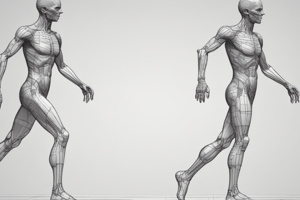Podcast
Questions and Answers
Which muscle group attaches at the lesser trochanter?
Which muscle group attaches at the lesser trochanter?
- Tensor fasciae latae
- Gluteus maximus
- Iliopsoas group (correct)
- Piriformis
Which ligament reinforces the anterior joint capsule of the hip?
Which ligament reinforces the anterior joint capsule of the hip?
- Ligamentum teres
- Pubofemoral ligament
- Ischiofemoral ligament
- Iliofemoral ligament (correct)
Which nerve is part of the lumbar plexus and supplies the femoral nerve?
Which nerve is part of the lumbar plexus and supplies the femoral nerve?
- Femoral nerve (L2-4) (correct)
- Sciatic nerve (L4-S3)
- Medial femoral circumflex nerve
- Obturator nerve (L2-4)
Which assessment tool is used to evaluate postural deviations and muscle balance?
Which assessment tool is used to evaluate postural deviations and muscle balance?
What can cause labral tears in the hip?
What can cause labral tears in the hip?
Which condition can lead to toe out in the gait pattern?
Which condition can lead to toe out in the gait pattern?
Which muscles are commonly involved in Low Back Pain (LBP)?
Which muscles are commonly involved in Low Back Pain (LBP)?
What are some common postural deviations mentioned in the text?
What are some common postural deviations mentioned in the text?
What are some assessment methods for Low Back Pain (LBP) mentioned in the text?
What are some assessment methods for Low Back Pain (LBP) mentioned in the text?
What are some interventions for gait deviations mentioned in the text?
What are some interventions for gait deviations mentioned in the text?
Flashcards are hidden until you start studying
Study Notes
Gait Analysis and Postural Evaluation
- Factors affecting posture: effusion, poor posture, repetitive activity, and soft-tissue imbalance
- Inspection of posture includes history of MOI, body types, Janda's Lower Cross Syndrome, and postural types
- Assessment methods for LBP include measuring leg-length discrepancy and palpation techniques
- Muscles involved in LBP include erector spinae, multifidus, and gluteus medius/maximus
- Common postural deviations include excessive pronation, supination, calcaneovalgus, calcaneovarus, genu recurvatum, genu valgum, and genu varum
- Gait terminology encompasses step, step length, step width, stride, gait cadence, velocity, stride time, stride length, kinematics, and kinetics
- Gait evaluation methods include quantitative measurements and qualitative visual analysis
- The process of gait involves alternating between stance and swing phases, with specific characteristics for each phase
- Efficient gait characteristics include minimal side-to-side motion, maximum forward motion, and a sinusoidal curve for center of gravity
- Running phases involve stance and swing, with specific joint movements and triplanar ground reaction forces
- Differences between running and walking gait include flight phase, ground reaction forces, and stance phase timing
- Interventions for gait deviations include guided cue words, strength training, flexibility exercises, and different shoes
Studying That Suits You
Use AI to generate personalized quizzes and flashcards to suit your learning preferences.




